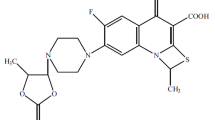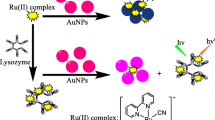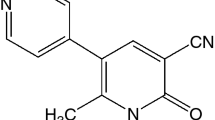Abstract
It was first found that 4-(2-pyridylazo)-resorcinol (PAR) can combine with lysozyme forming a polymolecular complex, with the molar ratio of 1:12 (lysozyme/PAR) in the medium of acetate buffer (pH 6.0). The fluorescence spectra suggested that PAR molecules may produce self-aggregation, and it was suggested that there are interactions between lysozyme and PAR possibly mainly on the cooperation of hydrophobic, electrostatic actions and chelate bond. The coordination complex of lysozyme-PAR can cause an enhanced resonance light scattering (RLS) signal with the scattering peak located at 521 nm. The increment of RLS intensity was linear with the concentration of lysozyme over the range from 1 ng mL-1 to 30.0 μg mL-1, with the limit of detection of 0.3 ng mL−1 (3σ, n = 5). Effect of experimental conditions, including temperature, pH, concentration of PAR, and the ionic strength on RLS were also tested. The proposed RLS method was successfully applied to analyze lysozyme in hen egg white, human saliva and tear samples without any special pretreatment. Compared with other methods, the proposed procedure is of high sensitivity and selectivity.
Similar content being viewed by others
Explore related subjects
Discover the latest articles, news and stories from top researchers in related subjects.Avoid common mistakes on your manuscript.
Introduction
4-(2-pyridylazo)-resorcinol (PAR) is a phenolic compound with a pyridine ring in its structure, and is one of the important reagents among heterocyclic azo dyestuffs [1].

PAR is widely used as an indicator of metal ions for the spectrophotometric determination [2, 3], based on the formation of PAR-ion color complex under appropriate conditions.
The resonance light scattering (RLS) of PAR has been discussed [4], that PAR self-molecules formed aggregations by hydrophobic action in neutral medium producing enhanced RLS signal. In this work, it was also found that PAR can produce RLS signals in aqueous solution, but the signal was weak and not stable, while lysozyme (the molecular structure was shown in Scheme 1) was added the RLS intensity was enhanced gradually. It was suggested that there would exist interactions between lysozyme and PAR, and the molar ratio of lysozyme and PAR to form coordination complex was 1:12, which was estimated by spectrophotometric method. So lysozyme can combine with 12 molecules of PAR forming the polymolecular coordination complex.
RLS is based on the fact that the aggregation of dye chromophore on the biological macromolecules, owing to their interactions, giving rise to strong RLS [5, 6]. In this paper, the RLS procedure was proposed to deal with lysozyme in real samples. The RLS intensity of PAR was enhanced remarkably owing to the formation of polymolecular coordination complexes of lysozyme–PAR. And the increment of RLS intensity was in a good linearity with lysozyme concentration in the range from 0.001 μg mL-1 to 30 μg mL-1, with the limit of detection (LOD) of 0.3 ng mL-1. The present method was applied for determining lysozyme in hen egg white, saliva and tear samples, and the results obtained from which were in a good agreement with the references, with recoveries in the range of 91.8–115.8%. Compared with general methods for testing lysozyme in egg white and human body fluids, such as enzyme-linked immunosorbent assay [7], fluorescence [8], polarography [9], chemiluminescence [10], and RLS with different chromophores such as Water blue [11], trimethoxyphenylfluorone-molybdenum (VI) [12], Ponceau 4R [13], the proposed method showed its potential advantages including high sensitivity, simply handling, and good selectivity.
Materials and methods
Reagents
The reagents used were all of analytical-reagent grade, and the doubly deionized water used throughout the procedure was made by Milli-Q system (Millipore, Bedford, MA, USA). Lysozyme (Sigma) was obtained from local market applied to prepare the stock solution with the concentration of 5 mg mL-1. PAR purchased from Xi’an Chemical Reagent Plant (Xi’an, China) was used as supplied to prepare a 0.05% PAR stock solution in alkaline medium, and diluted by doubly deionized water into a 100 mL brown calibrated flask. The acetate buffer at pH 6.0 and NaCl solutions were used to adjust the acidity and the ion strength of the scattering system. The stock solutions were stored at 4°C, from which the working strength solutions were prepared freshly as required before testing.
Apparatus
A Hitachi F-4500 fluorescence spectrofluorimeter (Tokyo, Japan) was used for all the fluorescence measurements, coupled with which a computer carried out the data process and plotting. While a UV–Vis spectrophotometer (model Lambda-40, Perkin Elmer, USA) was employed for acquiring the absorption spectra. And a pHs-3C digital pH meter (Shanghai Leici Device Works, China) was applied for pH measurements.
Procedure
At room temperature, 1.0 mL acetate buffer, appropriate volume of PAR and a series of lysozyme standard solutions or samples were added to the 10 mL comparison color tube in order, diluted by doubly deionized water and homogenized for determination. The RLS spectra were obtained by simultaneously scanning the excitation and emission monochromators of spectrofluorimeter from 400 nm to 650 nm without any wavelength interval (λ ex = λ em). And the enhancement of the RLS intensity was calculated from ΔI RLS = I RLS − I 0, where I RLS and I 0 was the RLS intensity for in the presence and absence of lysozyme, respectively.
Results and discussion
Fluorescence and RLS spectra of PAR and lysozyme–PAR
A series of experiments were carried out for testing whether PAR could emit fluorescence. The maximum excitation wavelength of PAR was observed at 302 nm, and its emission spectrum was obtained when excited at 302 nm as shown in Fig. 1. It can be seen that the emission peak shifted to the blue side and the maximum fluorescence intensity increased in the concentration range of 10–70 μmol L−1 then decreased with increasing concentration (70–300 μmol L−1), and the maximum emission intensity was obtained with 70 μmol L−1 PAR. When PAR concentration varied from 10 μmol L−1 to 150 μmol L−1, the emission peak was shifted from 364 nm to 350 nm. It was interesting that the beginning points of the spectral lines were almost identical, though the peak intensity and corresponding wavelength changed with the concentration of PAR. If the emission wavelength was fixed at 360 nm, the relationship between the fluorescence intensity and the concentration of PAR can be expressed in Fig. 2. And the fluorescence spectrum of lysozyme, PAR, and lysozyme–PAR was also obtained with the same concentration of lysozyme and PAR at 4 μmol L−1, as shown in Fig. 3; the emission peak was located at 339 nm, 364 nm and 346 nm, respectively. From the fluorescence spectra of PAR and lysozyme–PAR it was suggested that PAR molecules may self-assemble [14] and then react with lysozyme forming polymolecular complexes.
Figure 4 showed that the RLS spectra of PAR and lysozyme–PAR in the acetate buffer (pH 6.0) obtained by simultaneously scanning the emission and excitation wavelength, with the scattering peaks at 521 nm. As can be seen that there was no significant wavelength shift in the range of 400–650 nm, and the RLS intensity was greatly enhanced in the presence of lysozyme, which suggested a strong interaction existing between lysozyme and PAR. By comparing the RLS spectra of lysozyme–PAR and the absorption spectra of PAR, it can be found that the RLS peaks lay in the red side of the molecular absorption band of PAR (λ max 405 nm) in the range of 310–500 nm. According to the light scattering theory [15], it was suggested that the RLS peak was ascribed to the absorption of PAR. The RLS intensity was enhanced obviously in the presence of lysozyme, and the increment of RLS intensity (ΔI RLS ) was linearly proportional to the concentration of lysozyme at 521 nm, so this wavelength was selected for the determination of lysozyme.
Effect of temperature on RLS intensity
The influence of temperature on the RLS intensity was weak in the range of 15–30°C, but when the temperature was over 40°C the sensitivity of the system was obviously decreased. And ΔI RLS reached a maximum at about 20°C, considering both the sensitivity and the handling simplification of the method the whole procedure was carried out at room temperature 25°C.
Effect of pH on RLS intensity of lysozyme–PAR
Due to the interaction between lysozyme and PAR, influences of pH on the RLS intensity of PAR and lysozyme–PAR were tested by a series of solutions with different acidity. The RLS intensity of PAR did not change obviously with pH increasing, while that of lysozyme–PAR changed a lot. The RLS intensity of lysozyme–PAR increased when pH < 6.0, while with pH continuing to increase, the RLS intensity of lysozyme–PAR was decreased. Thus pH 6.0 adjusted by acetate buffer was selected as an optimum condition. With pH increasing, more negative charges on PAR molecule (owns two –OH groups on the phenyl; pKa1 = 3.1, pKa2 = 5.6) made it easy to bind to lysozyme and enhanced the RLS intensity, on the other hand, the increase of pH would also result in the aggregation of negative charges on lysozyme molecules (pI ≈ 11) [16], correspondingly the binding force between lysozyme and PAR was weakened and RLS intensity was diminished. Then the result of the two opposite effects was that at pH 6.0 the combination of lysozyme and PAR was the strongest, and the enhancement of RLS intensity arrived at the maximum.
Effect of the concentration of PAR on RLS intensity
The effect of PAR concentration was examined by testing the RLS intensity with a series of PAR standard solutions (0.5, 1, 5, 7, 10, 20, 30, and 40 μmol L−1). The optimum concentration for the assay was obtained from the plot of ΔI RLS against PAR concentration. The highest ΔI RLS was found with a 20 μmol L−1 PAR, which was applied in further research.
Effect of ionic strength on RLS intensity
The effect of ionic strength on the lysozyme–PAR system was carried out by testing the effect of different concentrations of NaCl on RLS intensity. The RLS intensity was stable as NaCl concentration was lower than 0.01 mol L−1, and it was reduced when more than 0.01 mol L−1. It was possible due to the decrease of the binding force between PAR and lysozyme, because the shielding effect of the charges on lysozyme resulted from increasing ionic strength, which was not beneficial to the formation of lysozyme–PAR complexes. And then 0.01 mol L−1 NaCl was selected to adjust the ionic strength of the system.
Performance of proposed method for lysozyme measurements
Under optimum conditions, a series of lysozyme standard solutions were examined for drawing a working curve. It was found that the enhancement of RLS intensity was linear with the concentration of lysozyme in the range from 1.0 ng mL−1 to 30.0 μg mL−1 with the LOD of 0.3 ng mL−1 (3σ, n = 5). The working regression equation was
The relative standard deviations (RSDs) of five determinations were 2.03%, 1.29%, and 0.94% for 0.01, 0.1, and 1.0 μg mL−1 lysozyme, respectively.
Interfering studies
The influence of foreign substances on the determination results was investigated. For the purpose, 0.1 μg mL−1 lysozyme containing increasing amounts of interfering species were analyzed. The results were summarized in Table 1, and it can be seen that the inorganic anions and amino acids had little influence on the determination under the permission of 5% error. And components abundant in hen egg white such as egg albumin, glucose and minerals and other proteins in saliva and tear also had no obvious effect on the determination of sub-nanogram level of lysozyme.
Applications
Determination of lysozyme in hen egg white samples
The present method was applied for the determination of lysozyme in hen egg white samples. Seven eggs purchased from local market were broken, from which the egg white was collected, and diluted with doubly deionized water in a calibrated flask and homogenized, and then stored at 4°C for further analysis. According to the interference studies other main components in hen egg white hardly interfered with the determination, so the sample stock solutions were used directly to determine lysozyme after diluted appropriately with doubly deionized water. The results were summarized in Table 2, and in order to testify the credibility of the present method the recovery studies were also carried out, which were in the range of 94.9%–111.6%. The content of lysozyme in hen egg white was from 3.48 mg mL−1 to 4.27 mg mL-1, which agreed well with that in the literature [17].
Determination of lysozyme in human saliva and tear samples
The proposed method was also used to determine lysozyme in human saliva and tear samples obtained from six and three healthy volunteers, respectively. The samples were stored at 4°C and diluted with doubly deionized water appropriately to ensure the concentration of lysozyme was in the linear range. The results were summarized in Tables 3 and 4 with the recoveries ranging from 91.8% to 115.8% for saliva and 95.5% to 112.6% for tear samples. The content of lysozyme obtained was 10.29–12.11 μg mL-1 in saliva and 1.048–1.318 μg mL-1 in tear, respectively, which was consistent with that of reference methods [18, 19].
Possible mechanism for the interaction of lysozyme and PAR
Based on the discussion of the fluorescence and RLS spectra for PAR and lysozyme–PAR, it was suggested that the interaction between lysozyme and PAR should not be ascribed to only one intermolecular force but to the cooperation of hydrophobic, electrostatic actions and chelate bond reactions. It is well known that PAR has some pairs of unshared electrons and two negative charges available for bond formation with species under certain conditions. A suitable molar ratio for the formation of lysozyme–PAR complex was obtained using spectrophotometry with its absorption spectra illustrated in Fig. 5. From this figure it can be observed that the characteristic absorption of lysozyme is at 280 nm. And the relationship between the maximum absorbance (A) for lysozyme and the molar ratio of PAR to lysozyme (CPAR/Clysozyme) was expressed in Fig. 6, from which it can be seen that there was an inflexion when the molar ratio was 12. It was implied the binding was not saturated only when CPAR/Clysozyme was higher than 12. So it was educed that one molecule of lysozyme can combine with 12 molecules of PAR, and form a polymolecular complex by chelate bond (may be coordination and electrovalent bond).
References
Anderson RG, Nickless G (1967) Heterxyclic azo dyestuffs in analytical chemistry. Analyst 92:207–238
Trypuć M, Chałat M, Mazurek K (2006) Solubility investigations in the Na2SO4+V2O5+H2O system from 293 K to 323 K. J Chem Eng Data 51:322–325
Wada A, Harada M, Okada T (2006) Kinetic monitoring of electrophoretically induced solute reaction by axial absorption detection with liquid-core waveguide. Anal Chem 78:4709–4712
Wei YJ, Qi XJ, Dun HJ, Wang HY, Lan RJ (2005) Resonance light scattering of 4-(2-pyridylazo)-resorcinol (PAR). Spectrosc Spect Anal 25:1289–1292
Ma CQ, Li KA, Tong SY (1997) Enhancement of Rayleigh light scattering of acid chrome blue K by proteins and protein assay by the scattering technique. Analyst 122:361–364
Ma CQ, Li KA, Tong SY (1997) Microdetermination of proteins by Rayleigh light scattering technique with acid green 25. Anal Chim Acta 338:255–260
Vidal ML, Gautron JL, Nys Y (2005) Development of an ELISA for quantifying lysozyme in hen egg white. J Agric Food Chem 53:2379–2385
Chong QJ, Li L (2004) Lysozyme enhanced europium–methacycline complex fluorescence: a new spectrofluorimetric method for the determination of lysozyme. Anal Chim Acta 511:11–16
Lan JG, Luo DB, Feng YL (2004) Micro-determination of protein containing SH- and -S-S- groups based on the polarographic wave of an electroactive derivative. Microchim Acta 148:299–304
Song ZH, Hou S (2003) A new analytical procedure for assay of lysozyme in human tear and saliva with immobilized reagents in flow injection chemiluminescence system. Anal Sci 19:347–352
Huang CZ, Lu W, Li YF, Huang YM (2006) On the factors affecting the enhanced resonance light scattering signals of the interactions between proteins and multiply negatively charged chromophores using water blue as an example. Anal Chim Acta 556:469–475
Wei Q, Li Y, Zhang H, Ding YL, Du B (2005) Rapid determination of ultra trace amounts of residual protein in penicillin based on its enhancement effects of Rayleigh light scattering on trimethoxyphenlyfluorone (TM-PF)–Mo(VI) complex. J Pharm Biomed Anal 38:232–238
Zhong H, Xu JJ, Chen HY (2005) A rapid and sensitive method for the determination of trace proteins based on the interaction between proteins and Ponceau 4R. Talanta 67:749–754
Valeur B (2002) Molecular fluorescence: principles and applications. Wiley-VCH Verlag GmbH, Weinheim
Miller GA (1978) Fluctuation theory of the resonance enhancement of Rayleigh scattering in absorbing media. J Phys Chem 82:616–618
Chen Z, Liu J, Luo D (1994) Biochemistry experiments. Chinese University of Sciences and Technology, Hefei, PRC
Stevens L (1991) Egg white proteins. Comp Biochem Physiol 100B:1–9
Tsang C, Samaranayake L (1999) Salivary lysozyme and related parameters of a predominantly Chinese: HIV-infected cohort in Hong Kong. Oral Dis 5:241–246
Hankiewicz J, Swierczek E (1974) Lysozyme in body fluids. Clin Chim Acta 57:205–209
Acknowledgement
The authors gratefully acknowledged financial support from the Natural Science Foundation, Shaanxi Province, China, grant No. 2006B05, and No. 04Jk145, and also supported by Opening Founding of Shaanxi Key Laboratory of Physico-inorganic Chemistry, Northwest University.
Author information
Authors and Affiliations
Corresponding author
Rights and permissions
About this article
Cite this article
Yue, Q., Song, Z., Dong, F. et al. Photochemical Behavior of Lysozyme-4-(2-pyridylazo)-resorcinol Polymolecular Complex and Its Analytical Applications. J Fluoresc 17, 505–511 (2007). https://doi.org/10.1007/s10895-007-0202-4
Received:
Accepted:
Published:
Issue Date:
DOI: https://doi.org/10.1007/s10895-007-0202-4











